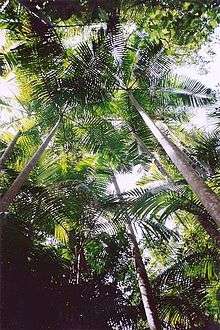Archontophoenix cunninghamiana
| Bangalow palm | |
|---|---|
 | |
| Bangalow palm at Middle Brother National Park, Australia | |
| Scientific classification | |
| Kingdom: | Plantae |
| (unranked): | Angiosperms |
| (unranked): | Monocots |
| (unranked): | Commelinids |
| Order: | Arecales |
| Family: | Arecaceae |
| Genus: | Archontophoenix |
| Species: | A. cunninghamiana |
| Binomial name | |
| Archontophoenix cunninghamiana (H.Wendl.) H.Wendl. & Drude | |

Archontophoenix cunninghamiana (Bangalow palm, king palm, Illawara palm, piccabben, piccabeen) is an Australian palm. It can grow over 20 m tall.[1] Its flower colour is violet and the red fruits are attractive to birds. It flowers in midsummer and has evergreen foliage.
The Piccabeen Palm grows in the wet subtropics on the sides of Mt Warning Volcano in northern NSW and over the border in Queensland's Lamington National Park, for example. It seeks a good water supply so ravines and grottos are well populated. Its fronds do not create a nesting environment for insects or macrofauna like rodents, so are a tolerable tree for urban environments. Originally in Australia from the landbridge created 45,000 years ago by the receding ocean levels during the last glacial, the probable 'native' environment in prehistory was Indonesia.
It has become a noxious weed in many areas where it has been used as an ornamental plant. In southern Brazil, it has become an invasive species, profiting from the local extinction of the endangered native palm Euterpe edulis.[2] In New Zealand, A. cunninghamiana could invade native forests, since it has the same ecological requirements as the native nikau palm. The Auckland Regional Council has included A. cunninghamiana on a list of plants requiring further research on their potential to adversely affect the environment.[3]
In the United States, the palm is commonly cultivated in California from San Luis Obispo south to the Mexican border and in coastal South Florida.
References
- ↑ Brooks, A. K. (1993). "Archontophoenix cunninghamiana – New South Wales Flora Online". PlantNET - The Plant Information Network System. 2.0. Sydney, Australia: The Royal Botanic Gardens and Domain Trust. Retrieved 9 Mar 2013.
- ↑ Frisch & Frisch (2005), page 354, Christianini (2006)
- ↑ ARC Research Programme
Christiani, Alexander V. - "Fecundity, dispersal, and predation of seeds of Archontophoenix cunninghamiana H. Wendl & Drude, an invasive palm in the Atlantic Forest". Revista Brasileira de Botânica, V.29, no.4, October/December 2006 Portuguese & English abstracts.
Frisch, J.D. & Frisch, C.D. - Aves Brasileiras e plantas que as atraem [Brazilian birds and plants which attract them]: 2005, São Paulo, Dalgas Ecotec, ISBN 85-85015-07-1
| Wikimedia Commons has media related to Archontophoenix cunninghamiana. |